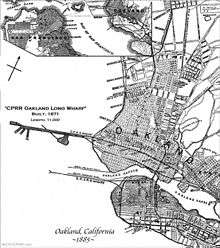Oakland Long Wharf

The Oakland Long Wharf, later known as the Oakland Pier or the SP Mole, was a 11,000-foot railroad wharf and ferry pier along the east shore of San Francisco Bay located at the foot of Seventh Street in West Oakland. The wharf had three piers at its west end for use by the Southern Pacific, Western Pacific, and the Key System.
History
The pier began as a smaller landing named Gibbon's Wharf, which extended from Gibbons Point (present day Oakland Point), westward into San Francisco Bay.
- Central Pacific
In 1868 the Central Pacific Railroad acquired this pier which it renamed the Oakland Long Wharf and immediately began extending and improving. The CPRR floated freight to San Francisco starting in 1871. Part of the wharf was filled in between 1879 and 1882, creating a mole. Local commuter trains also used the pier, while trains of the Pacific Railroad (aka: "First Transcontinental Railroad") used another wharf in nearby Alameda for about two months in 1869 (September 6 - November 7), after which the Oakland Long Wharf became the western terminus of the Pacific Railroad as well. From there San Francisco Bay ferries carried both commuters and long distance passengers between the Long Wharf and San Francisco.

- Southern Pacific
The Central Pacific's operations were consolidated under the Southern Pacific in the 1880s, and in 1882 the Oakland Pier was opened about a half-mile east of the west end of the Long Wharf Mole, which was then used only for freight until being abandoned in 1919. Freight trains served docks just south of the train shed after the original was abandoned. The mole became one of the busiest piers in the United States. A huge stained-glass window of the SP logo was placed on the western end of the train shed in 1929. When the building was demolished, it was removed and put in storage. It is now at the California State Railroad Museum in Sacramento, California.
- Commuter trains
After January 15, 1939 the electric commuter trains of the East Bay Electric Lines no longer ran to the Oakland Pier but instead used tracks on the lower deck of the new San Francisco-Oakland Bay Bridge, running to the Transbay Terminal in San Francisco. Intercity passenger trains continued to run to Oakland Pier until 1958 when Southern Pacific ferry service from the Ferry Building in San Francisco to Oakland Pier was discontinued, replaced by buses over the Bay Bridge from Oakland's 16th Street Station.
Demolition
Throughout the pier's existence, progressively greater portions of the bayshore tidelands were filled in. It was demolished in the 1960s to make way for an expansion of the growing container ship facilities of the Port of Oakland. The only structure that remains of the Oakland Long Wharf is the SP Mole's switchman's tower, which was restored and moved to Middle Harbor Shoreline Park.
In popular culture
The mole in its latter years can be seen at the beginning of the 1957 movie Pal Joey as Frank Sinatra's character arrives by train and makes his way to the ferry.
See also
Bibliography
- "A Long Wharf with a Massive Mole" from A Brief History of Oakland (1994) by Robert Douglass
- "Southern Pacific's Western Division", John R. Signor, Signature Press, 2007
- "Red Trains in the East Bay", Robert S. Ford, Interurban Press, 1977
External links
| Wikimedia Commons has media related to Oakland Long Wharf. |
- Middle Harbor Shoreline Park map
- Photo: Oakland Long Wharf from Goat Island (Yerba Buena Island) 1886
- alamedainfo.com
- CPRR Museum: Oakland Long Wharf
- CPRR Museum: SP Publ. "From Rail to Trail"
Coordinates: 37°48′00″N 122°19′52″W / 37.80°N 122.3310°W